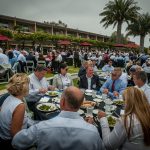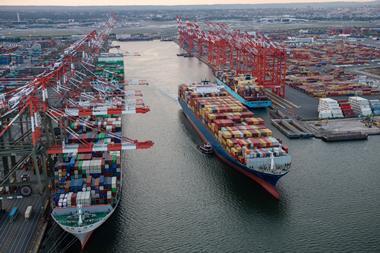All seven annual Finished Vehicle Logistics North America conferences have taken place during periods of recovery and growth for the industry. At the latest event, many thought sales were at their peak, and warned that OEMs and providers would need to be efficient even as the market changes. Marcus Williams and Christopher Ludwig report. Rachael Hogg contributed to this report.
 Newport Beach in California was again the perfect setting for this year's conference, where the sun continues to shine on the North American automotive and vehicle logistics industry. With an improving labour market, low interest rates and historically low oil prices, analysts are forecasting another record year for US sales and continuing growth for North American light vehicle assembly.
Newport Beach in California was again the perfect setting for this year's conference, where the sun continues to shine on the North American automotive and vehicle logistics industry. With an improving labour market, low interest rates and historically low oil prices, analysts are forecasting another record year for US sales and continuing growth for North American light vehicle assembly.
Meanwhile, with sales and production volumes climbing, fuel costs low and service levels high across rail and truck transport, the country’s vehicle logistics sector has arguably never had it so good.
Forecasting firm PwC Autofacts predicts sales will reach 17.8m units this year (from 17.4m in 2015), driven in particular by a shift to SUV, crossovers and trucks, which are so far up more than 8% this year, while midsized sedans and small cars have declined by nearly as much. With more carmakers shifting production of higher-margin trucks and SUVs to the US, it is also good news for most American vehicle plants – and for many finished vehicle logistics providers.
In this report...
Thus far, at least, there is plenty to suggest that the North American vehicle logistics industry is leaner and healthier than it has been at any point in the past few decades, not least following the experience of the global financial crisis of 2008-2009, and in the ensuing years of recovery and adjustment.
“Downturns give us the chance to eliminate waste, to acquire new businesses, to tighten operations and drive innovation by way of necessity,” noted Sarah Amico, chairman of Jack Cooper Holdings, owner of North America’s biggest finished vehicle carrier, Jack Cooper Transport. “Our experience in the downturn of 2009 certainly seems to have validated these virtues. As an industry we suffer tremendous uncertainty and a number of companies simply didn't make it. But for those who survived we emerged smarter, better and faster.”
Luca Kolcaj, manager of finished vehicle operations at Fiat Chrysler Automobiles US, credited the vehicle logistics industry with investing in the right capacity and services, particularly across road and rail transport. “We went through some rough times a few years ago, but I have seen many improvements thanks to investment in trucks and railcars across the industry,” he said. “I’m sleeping much better this year than I was in 2014.”
However, Amico warned that the industry had to prepare for a change in the current economic cycle. She recalled an Old Testament story about an Egyptian pharaoh who dreamed of seven healthy cows being eaten by seven skinny cows that nevertheless grew no fatter after eating them. The seven fat cows represented seven years of prosperity while the scrawny ones represented seven years of coming famine.
“Like those first seven cows in the pharaoh's dream, these are the good times,” she said. “We are in the year of the fat cow.”
- Click here to view videos of the main sessions from the conference
- News: logistics versus rising wages in Mexico
- News: a mixed bag for capacity
- News: kicking inefficient habits on the road
- News: ETA differences
- News: Scratches and missing keys in Mexico
- News: OEMs want data-literate carriers for remarketing business
- Crossfire panel: talking till the fat cows come home
Whether these investments or arrangements will help the industry maintain efficiency and respond to a downturn, however, remains to be seen. Likewise, should the commodities market change, and more railways capacity swing back towards energy goods, would automotive logistics suffer?
Most executives at the conference were optimistic, with OEMs and providers pointing to better IT tools, communication and collaboration across the sector as a good basis to manage and respond to change. And with investment continuing in many areas, including assembly in Mexico or at truck and SUV plants in the US, some providers and carmakers need to be as equally prepared for sunny days and fattening cows as they are for a tempest and a calf with little meat on its bones.
Seven fat years followed by seven uneven ones [sta_anchor id="1"]The seven years parable also bears some resemblance to the US vehicle sales market, which if it does reach a new record this year will have grown for an unprecedented seven consecutive years. Will famine now follow the feast?
Not quite, according to Brandon Mason, lead analyst for the Americas at PwC Autofacts. He does predict that following a high point this year, US light vehicle sales will declined to 16.5m units by 2018, before recovering back towards their current peaks by 2022. In some cases, the fattest cows grow even bigger: crossovers and SUVs are expected to continue rising in market share at the expense of midsize and smaller cars.
However, while sales might become a skinnier cow, increasing product localisation, combined with growing SUV exports, should support continued growth of North American light vehicle assembly over the next seven years. Mason expects output across the US, Mexico and Canada to increase from 17.5m units in 2015 to 20m by 2022. That output should continue to support increased vehicle flows across the continent by truck and rail.
Again, some cows get fatter at the expense of others: Mexico is expected to capture most of that growth, forecasted to grow from 3.4m in 2015 to 5.1m units by 2022; Canadian assembly is expected to decline in the period.
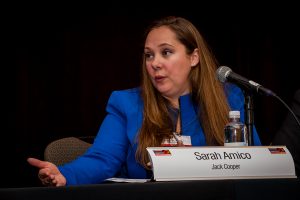
There are also questions over how volume will flow through North American vehicle-handling ports. Brandon Mason had earlier predicted a decline in non-NAFTA vehicle imports by as much as 50% over the coming years, thanks mostly to a shift of products out of Japanese, South Korean and German plants to the US and Mexico. He acknowledged that many factors could influence this development, however, including currency shifts, the ratification (or not) of the Trans-Pacific Partnership and even the potential of Chinese vehicle imports (following recent moves by Volvo Cars and GM to export to the US from China). However, he still expects a decline in imports from outside North America to the US by around 30-35% over the next 5-6 years.
However, whether such a decline comes to pass, and the extent to which it may hit US vehicle-handling ports, is unclear. Growing exports out of Mexico, for example, could replace some of this volume, though rail remains dominant. Currently around 85% of US and Canadian-bound exports from Mexico move via rail transport, according to Kelley Anderson, vice-president of automotive for Kansas City Southern (whose Mexican division is one of two class one railways in the country); he maintains that the industry has the capacity and investment power to handle any increase.
However, carmakers are using or considering more short-sea options. Glenn Clift, president and chief executive officer of Glovis America, a logistics subsidiary of the Hyundai Motor Group, revealed that Kia’s new plant in Pesqueria, close to Monterrey – which started shipping vehicles to the US the day the conference finished on June 9th – will use both rail transport for vehicles west of the Mississippi, while vehicles for the east coast would use short-sea shipping. Other carmakers, including GM, FCA and Nissan have also looked at increasing short-sea shipping.
Brian Mason, vice-president of planning, analysis and development at Pasha Automotive Services, which runs a major vehicle-handling terminal at the port of San Diego in California, as well as San Francisco and Grays Harbor in Washington state, said the company was encouraging short-sea deliveries from Mexico to the west coast. He said that vehicles that arrive to San Diego from Mexico by sea versus rail have considerably fewer damages.
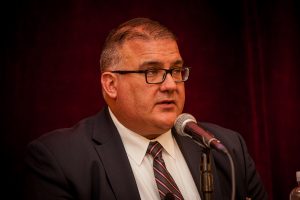 Brian Mason at Pasha said that vehicles that arrive from Mexico by rail to San Diego have higher damage rates than they do by ocean
Brian Mason at Pasha said that vehicles that arrive from Mexico by rail to San Diego have higher damage rates than they do by oceanNorth American vehicle exports beyond the continent also remain difficult to predict. While US exports have declined overall recently, thanks in part to the strength of the dollar, the global growth in SUV sales could support more global exports, said Brandon Mason. Mexico, meanwhile, could see a big rise in global exports once more plants come online. Bill Kerrigan, vice-president of logistics for terminal operator SSA, pointed to forecasts by Consultancy.uk that suggested Mexico’s global vehicle exports could rise from 500,000 this year to 1.7m by 2020 (although that would depend, in part, on recovery in the South American and especially Brazilian market). That would put a major strain on capacity and space at existing Mexican ports like Veracruz and Lázaro Cárdenas, he said.
An example of the complexity of North America’s changing vehicle trade can be found at FCA. For several years, the carmaker had increased Jeep exports from the US; however, global production of models had since brought those numbers down, according to Luca Kolcaj.
“We have partnerships and joint ventures in China where we are building Jeep products for the market over there. We have opened the Pernambuco plant in Brazil [that is also building Jeeps]. Depending on the market and the need, that is where the strategy is going to go,” he said.
He added that the carmaker would still export “bread and butter” products from the US, such as the Jeep Grand Cherokee and Wrangler, though decisions over exports or localisation would be driven by market developments. At the same time, the carmaker has increased its imports to the US, notably of the Jeep Renegade, which is built in Italy, along with several other Fiat models.
Healthy investments up to now [sta_anchor id="2"]This somewhat mixed picture might make it more difficult to forecast and plan for the next direction that the North American industry will take. However, executives can take solace in the fact that current capacity and network planning seems to have resulted in a healthy balance of assets and services across most vehicle logistics modes.
For instance, Nissan and FCA executives are impressed with available trucking capacity.
“I haven't been in a situation yet this year where I needed a truck and I couldn’t get cars to where they needed to be,” said Kolcaj.
Lee Hansen, senior buyer for vehicle logistics at Nissan North America agreed and pointed out how the situation had improved considerably from the “nightmare” of two years ago, when bad weather and a surge in energy commodities lead to a high amount of vehicles waiting to be shipped.
 Nissan's Lee Hansen (left) and FCA's Luka Kolcaj said that truck and rail capacity are generally in balance right now
Nissan's Lee Hansen (left) and FCA's Luka Kolcaj said that truck and rail capacity are generally in balance right now“For the US, the capacity is out there,” he said. “We have several carriers that we work with and they have come to us with new ideas and driven out inefficiencies.”
In Mexico, where initially rail providers were slow to deploy assets, there is now a concerted effort to make sure the industry has adequate rail wagons. Kelly Anderson from KCS said: “We are trying everything we can to turn that [deficit] around and provide the product the OEMs are looking for at a price that makes sense.”
There are also a number of infrastructure projects underway in Mexico to take out bottlenecks by building rail bypasses in urban areas or at ports, although Anderson points out that Mexico is struggling with a lack of funding and construction delays on a number of important projects. These include bypasses in major urban areas and ports, as well as rail infrastructure at certain plants, notably for Kia, which is delayed.
Others also pointed to the need for smarter investments from OEMs and providers, including in areas that might be overlooked to some extent, such as plant, port or rail yards. Dennis Manns, who previously ran outbound logistics for American Honda, but since last year is chief commercial officer for yard and equipment management firm, Road & Rail Services, warned that a poorly designed or executed yard operation could have consequences for decades, including the need to constantly hire external yard space – a situation that has become prevalent at many ports and plants.
“Yards are one of the most overlooked opportunities for OEMs or providers. If that piece of land is not laid out right, you will pay for that for the next 20-30 years, since that is how long you generally stay in those facilities,” he said. “Everything is based off the yard layout, it impacts all of your labour and all the other service providers there. You will be challenged to find efficiencies for the life of the property.”
 GM's Bryan Burkhardt (left) and FCA's Marc Brazeau (right) said that each OEM had invested in rail infrastructure at plants in North America
GM's Bryan Burkhardt (left) and FCA's Marc Brazeau (right) said that each OEM had invested in rail infrastructure at plants in North AmericaEven here there were signs that carmakers have been willing to make capital investments in improving vehicle logistics operations. After decades of trying, FCA recently added a direct rail link at its plant in Brampton, Ontario, according to Marc Brazeau, director of outbound and Mexico logistics.
“At capital planning meetings, plants are looking for big capital spends for a long-term programme, while logistics might be looking for $6m to pave a yard,” said Brazeau. “You think it would be easy, but [logistics has] a hard time competing for capital.
“It puts the onus on us to have a really strong business case,” he added. “The Brampton rail project took 30 years, but we finally hit on the right business case at the right time.”
General Motors, meanwhile, is adding rail spurs at several plants in the US to improve handling and reduce logistics costs, including at a plant in Detroit, according to Bryan Burkhardt, director of global logistics operations. “We're not interested per se in investing in a port, but we've added rail at our Detroit Hamtramck plant, which was a good business case for us over the long term,” he said.
Subaru has also expanded its rail and truck yard at its plant in Lafayette, Indiana, to accommodate expanded production and improve throughput, according to Gerald Lee, vice-president of vehicle planning and logistics at Subaru of America.
“We’ve expanded the rail yard to 144 spots, while we also moved trucks away from what I would call ‘Boardwalk and Park Place’ to operate much better than they have been.”
Despite investments across the sector, there is room for improvement across logistics operations. Marc Brazeau sees opportunities for better collaboration between OEMs and their logistics providers, such as rail ramps. He also pointed to technology as an area where big gains could still be made.
Bryan Burkhardt also pointed to the potential of technology and network engineering as important areas of improvement for GM. “The low hanging fruit might be network design. There is so much change in our networks, and each changes presents more opportunity,” he said.
Water, water everywhere and not a place to park [sta_anchor id="3"]Despite the investment and efforts at route optimisation across many companies, there are plenty of old fashioned space and capacity issues in parts of the North American network – though not always because of growth in sales.
At vehicle-handling ports, for example, strong sales and a high number of vehicle launches have increased throughput at many ports, requiring not only fast turnaround but also extra space to hold vehicles.
On the other hand, the slowdown in some model segments has increased inventory-holding requirements at other terminals, especially given the ‘build-to-stock’ model for most brands across North America. This has been the case for Hyundai and Kia vehicles at certain locations, as well as other brands.
 Editor Christopher Ludwig speaks with (left to right) GM's Bryan Burkhardt; FCA's Marc Brazeau; Glovis's Glenn Clift; Subaru's Gerald Lee
Editor Christopher Ludwig speaks with (left to right) GM's Bryan Burkhardt; FCA's Marc Brazeau; Glovis's Glenn Clift; Subaru's Gerald Lee“Our business has changed quite a lot over the past year,” admitted Glenn Clift at Glovis. “It used to be that every car coming off a vessel was sold and the challenge was to get the vehicles delivered. We're now dealing with an inventory situation.
“We need to be flexible, but not invest in under-utilised assets,” he added. “We're getting parking lots to handle the inventory situation today, but there's no indication that will last. It's difficult to be flexible and handle the situation we have today.”
It is a situation found at a number of major ports. In San Diego, Brian Mason revealed that Pasha was on a constant search for space to use as temporary parking. Although San Diego can hold around 30,000 vehicles, vessel bunching and high inventory counts for some OEMs have meant the port is often at capacity. The port will often see 3,500-4,000 units in a single port call, while it was possible for several vessels to call at once.
“If we get three ships and each wants to drop 4,000 vehicles that day, beyond the labour challenge that is a sudden demand for 12,000 parking spaces,” he said. “That is a huge challenge. One thing we're trying to work on is more frequent vessel calls with smaller sizes.”
In meantime, Pasha was working with its OEM customers to agree offsite locations. This past winter, for example, it started using SeaWorld’s large parking lot during the offseason to store vehicles.
Peter Bresnee, director of operations at Glovis, confirmed similar space constraints that result from bigger ships and longer dwell times. Bresnee said a 15-day dwell time would be “a utopia” that was not going to happen anytime soon.
“OEMs have their own circumstances but it's not uncommon to see vehicles on site for upwards of 45 days,” he said. “Space is needed and I don't see time in the near future where we will be able to reduce our footprint.”
OEM executives agreed that they were facing similar issues at its ports and plants. FCA’s Kolcaj noted the big influx of vehicles into the ports as well as some plants, but said that FCA leaned on its service partners to find options. Nissan’s Hansen agreed and said with land around ports and plants limited in terms of expansion, the carmaker needed service providers to find any additional land required.
For some ports, ro-ro operators may be competing with space for much larger container business. At the port of Long Beach, California, where Toyota and Mercedes-Benz US have important terminals, vehicles account for just 0.19% of cargo, compared to more than 76% for containers. However, Noel Hacegaba, chief commercial officer and managing director of operations at the port of Long Beach, said the port wanted to see finished vehicle traffic increase, and that major investments to improve rail handling, deepen berths and replace a bridge at the port would have positive impacts for all cargo.
One possible solution to deal tight space could be building multi-storey parking garages, as has been done in a number of major European ports where space was an issue, including Germany’s Bremerhaven, Belgium’s Zeebrugge or Southampton in the UK.
However, Noel Hacegaba and Brian Mason both said that the numbers have just not worked out whenever they have studies such investments. “That appears to be more of a solution for Europe, where space is more limited,” said Hacegaba.
Bresnee, who worked previously for Mercedes-Benz USA, said that all the studies he had seen for such investments in the US just didn’t add up. “Nobody has the fortitude to have that battle with their finance department,” said Bresnee. “It could work well but I can't imagine I'll see one in this lifetime.”
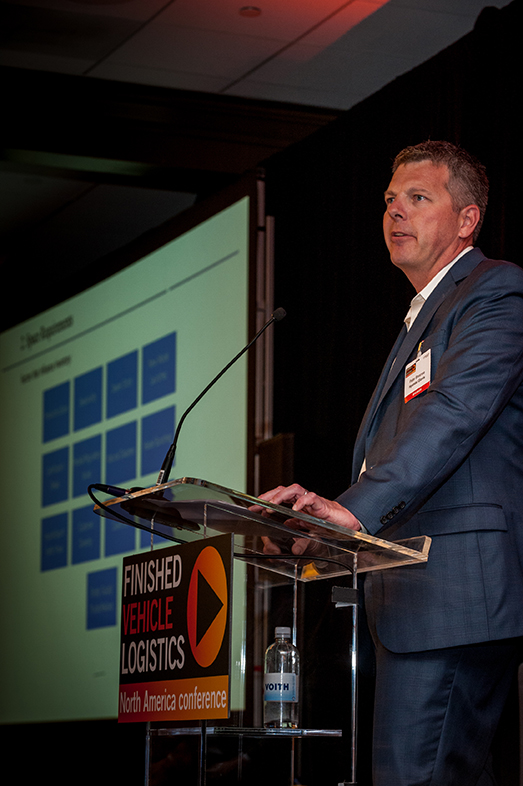 Peter Bresnee at Glovis said that it was not uncommon for vehicles to wait 45 days at ports before moving on to dealers
Peter Bresnee at Glovis said that it was not uncommon for vehicles to wait 45 days at ports before moving on to dealersMexico’s port of Veracruz, meanwhile, has been an example where such a structure existed, which Volkswagen has used for many years. However, the carmaker is set to lose this garage as the port develops the land for other purposes.
Meanwhile, some carmakers are looking at new port opportunities across North America. Last year, GM started using Freeport, Texas, managed by Höegh Autoliners, in the Gulf of Mexico, not far from where BMW has opened a terminal with WWL at Galveston. “Any time there's a new opportunity and everyone can win it makes relationships stronger and helps financials,” says Bryan Burkhardt. “[Freeport has] worked out well for us and we're very pleased.”
Brazeau said that FCA is also considering port options in the Gulf, including using one as a potential ‘anchor’ port in the region. “We already have anchor ports in Baltimore and San Diego and setting one up on the Gulf coast is interesting to us,” he said. “We're looking at it this summer so we can have an anchor port across the coasts and through Canada and Mexico as well. It's part of our strategy.”
Glenn Clift confirmed that Glovis was also exploring new port options for Hyundai and Kia. “We're looking at ocean ports, including a port in northern California, although the west coast is difficult to find capacity,” he said. “We’re looking on the east coast, while we've looked at the Gulf coast but not figured a way to fit it into our network. With the factory in Mexico coming online, it may change a bit.”
More on North America import and export vehicle flows and port processing will be discussed in more detail at the upcoming Import Export North America conference in Baltimore, August 10th
Mexican progress and standoffs [sta_anchor id="4"]The development of infrastructure in Mexico continues to be a perennial issue, especially as carmakers add more plants and production capacity. Export services northbound have remained mostly adequate this year, although fortune may be partly to thank. With most Mexican plants geared towards small cars, and US demand for such vehicles declining, Mexico’s vehicle exports to the US have actually fallen so far this year compared to 2015 – although with Kia and Audi production starting, that should soon reverse.
Nevertheless, Brandon Mason from PwC said that the shift in small car demand had even resulted in a downgrade in his forecast for Mexican production of around 100,000-200,000 units per year by 2022 compared to earlier outlooks.
However, with Mexico still expected to increase to around 5.1m vehicles per year by 2022 – a 50% rise compared to current levels – there will be further pressure on railways, trucking capacity and ports. Over the past two years, for example, a surge in the Mexican domestic market – including for subcompact imports from Asia – has led to shortages in haulier capacity from ports and plants to dealers.
While the supply of rail wagons in Mexico may be less of a concern than it was a few years ago, the network is still plagued by delays and bottlenecks, especially where tracks move through urban areas or ports. In the central Bajío and region and further north towards the border, such delays have a tendency to result in higher levels of damage, theft and vandalism.
Despite these challenges, however, executives from the Mexican railway sector are confident that the trains can take the strain. Kelley Anderson from KCS told delegates that the projected increase in exports from Mexico to the US and Canada will result in around 180,000 more vehicle exports over the next year compared to last year. If you assume 100% of those vehicles move by rail (despite the average split being around 85:15 between rail and ocean) that would require around 0.91 more trains per day. By 2018, growth will result in as many as 1.13m more vehicles, or 5.82 trains per day; by 2020, it would be 1.6m more units by rail, requiring 8.2 more trains per day.
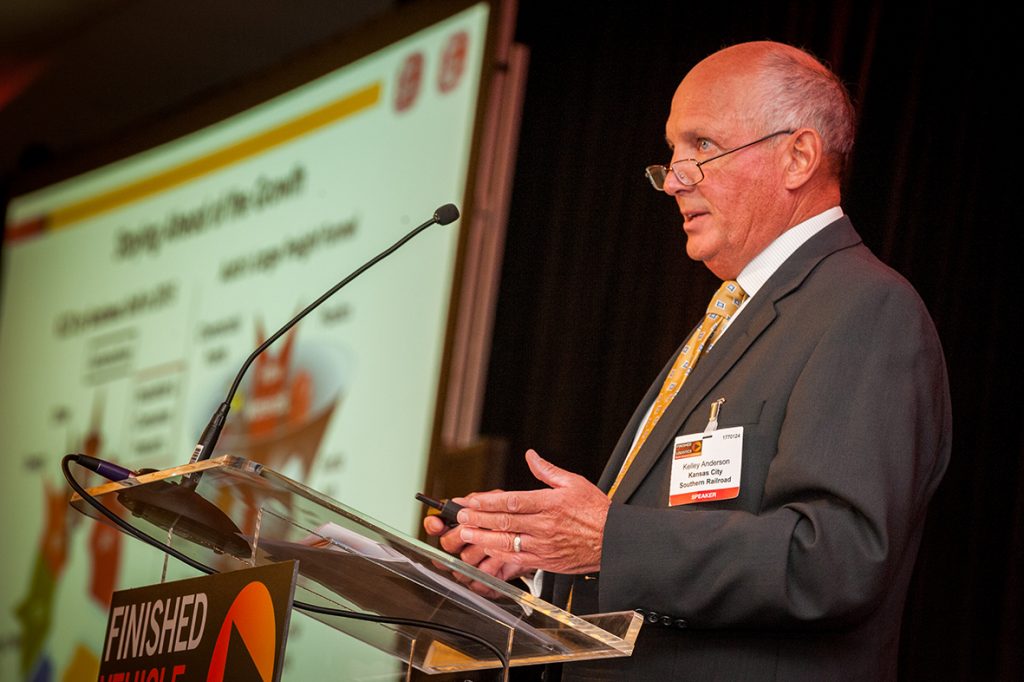 Kansas City Southern's Kelley Anderson said that rail providers in Mexico would have the capacity to handle increased in vehicle exports to the US and Canada
Kansas City Southern's Kelley Anderson said that rail providers in Mexico would have the capacity to handle increased in vehicle exports to the US and CanadaAccording to Anderson, both KCS and Ferromex will be able to absorb those increases. “Logistics providers in Mexico are ready to invest, we have adequate equipment, and we will be able to handle the increased volume,” he said.
He added that the pool of rail equipment in Mexico has increased over the last three years since equipment manager TTX introduced new rules to redistribute wagons based on the equity they invest. That increase in train assets along with the increase in production makes for a denser network, with providers able to run faster and more efficient point-to-point services.
However, a denser network of the kind needed in Mexico also needs investment in facilities and track improvements. One project underway is the Celaya bypass, a $430m project to reroute freight rail around the city and avoid congestion and slow speeds, which is 70% complete. It should have been finished already except the government ran out of money and there is still $200m worth of investment required. It is one of the most important rail projects going on in Mexico – probably the most important according to Anderson. KCS is working with Ferromex and the Mexican government to advance the project.
KCS is also planning to go directly into the port of Veracruz, something it does not do at the moment, handing off vehicles to its competitor. KCS plans to go in with a direct route once modernisation work to provide double track rail infrastructure at the port is complete, which is expected to be sometime in 2017. That said, the proposed automotive terminal at the port has been on the books for almost 20 years and is still not complete.
That could mean that, even if more trains are able to access Veracruz directly, the vehicles could hit a wall of congestion. According to Bill Kerrigan from SSA Marine, which runs a large terminal in Veracruz and is currently investing in a major operation in Lázaro Cárdenas, issues stem as much from capacity in Mexico as from the way OEMs and shipping lines move vehicles through ports unevenly.
“They don't work in an ideal way so we have to sit down with the port authorities and ask how do we put together this puzzle so it works for everybody,” said Kerrigan.
The rapid growth in Mexican production is also causing problems in other areas. GM’s Burkhardt admitted that labour and skills availability is a concern, especially with OEMs opening plants in similar locations. GM will expand its plant in San Luis Potosi, for example, while BMW and Ford will both open plants in the vicinity over the next three years.
“It will be a real issue,” he admits. “When there's a bunch of plants coming in to one area they will be competing for resources. How do we make sure we can retain folks?”
With Mexican states competing for investment, there are also questions over political stability and the government’s ability to meet commitments. After a governor from an independent party was elected last year in Nuevo Léon, for example, he called into question the level of incentives and support that the state government had promised Kia for its plant near Monterrey.
Following months of negotiation, the two sides were reported to have reached an agreement around the end of May. According to the Wall Street Journal, along with lower tax incentives, the new deal cancelled more than $100m in state-financed highway improvements near the Kia plant and reduced the number of rail spurs planned for the plant yard from five down to two.
Along with the long-term reduction in capacity, it has also meant that the plant opened last month without a direct rail, which may not be complete for 1-2 years. For now, the carmaker is relying on trucks to move cars to another rail shuttle, or to the port of Altamira for export (which also lacks a rail link).
 Glovis's Pat Foran said that Kia is currently using a truck shuttle from its new plant in Mexico until a rail link is finished at the facility
Glovis's Pat Foran said that Kia is currently using a truck shuttle from its new plant in Mexico until a rail link is finished at the facility“The rail infrastructure is still in planning stages, and hasn’t initiated,” said Patrick Foran, operations support at Glovis America. “We are doing a truck shuttle for outbound rail, which will be a temporary solution since that adds another touch to the car, which of course we want to remove so that we can get product moved faster and more efficiently. Kia Motors Mexico is working to get that issue corrected very quickly.”
Despite all the investment in Mexico, there are worries that delays and uncertainty about such infrastructure problems could hamper long-term growth and logistics efficiency from Mexico. As the labour market strains, especially for automotive production, wages will probably increase, according to Brandon Mason. That could make the differential costs in logistics even more important.
“Where I would look in addition to labour cost is the rail infrastructure and its development there,” said Sarah Amico. “I would also look at some of the cross-border trucking regulatory controls. I would track those two very closely to assess the relative competitiveness of the market in Mexico.”
Turning potential into reality [sta_anchor id="5"]While carmakers and logistics providers could point to investment in logistics assets and facilities that have supported growth, it is less clear if the sector has made enough major strides in efficiency and innovation to sustain a downturn or even further changes to the network. Glenn Clift, for example, admitted that it has been years since Glovis and Hyundai-Kia carried out an in-depth study to assess whether its current network had the right balance of truck and rail transport, given changes in the market and the price of fuel.
Other executives pointed to the importance of regular network design and optimisation tools. Brazeau said that FCA is now using Llamasoft technology to monitor changes in its network. With this system and other tools, he suggested that FCA could make adjustments across its network as often as every 4-6 weeks, if necessary.
At Jack Cooper, Sarah Amico also pointed to the company’s Llamasoft-based ‘Da Vinci tool’, a route optimisation system that tracks hours-of-service and load factor assessments along with other critical metrics.
Amico also referred to the benefits brought in last December by the Surface Transportation Reauthorisation and Reform Act (or FAST Act), which included an amendment to rules governing the trucking sector to allow greater flexibility in the use of vehicle transporters and established a longer trailer length to improve capacity. For example, it paved the way for logistics companies to use convertible equipment that can carry both vehicles and general freight, such as the system offered by Convertible Trailer Manufacturers (CTM).
However, CTM's chief executive, Bill Pawluk suggested that even having such equipment available would not be enough without having the right data and visibility across the network to match flows.
“We all know that there is a tremendous under-utilisation of our carrier assets because they are built specifically for transporting finished vehicles,” he said. “At the same time we have all this new technology and connectivity – there must be some way to use these to our benefit. Currently it is highly under-developed and under-used.”
Executives brought up many opportunities to use technology to enable a more open, collaborative delivery network, from load exchanges to using in-vehicle telematics to capitalising on data mining. However, much of these ideas remain only ‘potential’ for the time being.
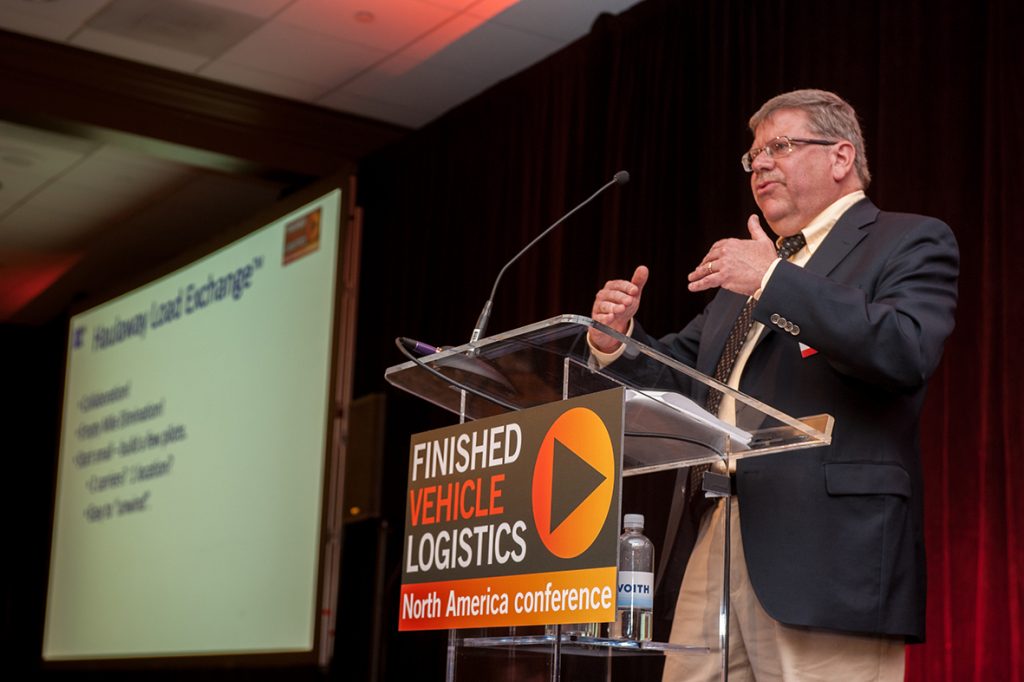 Steve Tripp from ICL proposed a national 'haulaway exchange' that would allow logistics providers to move vehicles for other OEMs using a system of debits and credits
Steve Tripp from ICL proposed a national 'haulaway exchange' that would allow logistics providers to move vehicles for other OEMs using a system of debits and creditsSteve Tripp, vice-president of global strategy and execution at ICL Systems, for example, introduced the idea of a haulaway load exchange that would allow outbound carriers to share finished vehicle deliveries, opening up available capacity regardless of existing contracts. The current problem is that each OEM has separate contracts with different carriers, and different rates and service agreements. With Tripp's idea, one carrier could haul for another based on a credit-debit system. For example, if carrier A delivered a car to a dealer 50 miles away for carrier B, they would earn a credit of 50 miles. Larger vehicles could earn a multiplier to the mileage. The exchange could either be arranged between two or three carriers, or in the best case, a national exchange could keep track of all credits and debits across the entire industry.
Tripp said the system would be good for OEMs because it would get vehicles to dealers faster, while it would be good for the haulaway sector because it would allow carriers to optimise routes and loads across multiple brands and destinations.
Though not new, telematics is another area with plenty of potential to add value to supply chain operations. Virtually anything that can be monitored on a vehicle can be transmitted via telematics, a fact not lost on the carmakers. In fact, both FCA and GM indicated that their companies were on the verge of breakthroughs in using telematics for tracking and controlling some aspects of vehicle logistics.
FCA's Marc Brazeau said his logistics team had been working with FCA’s engineering group to identify how Chrysler’s infotainment system, ‘uConnect’, can be used for distribution. The system has navigation functionality and features a range of media synchronisation capabilities.
“Probably 40% of fleets are telematics enabled so far,” said Brazeau. “We are working internally to identify three or four things that need to be ready when the fleets are available, such things as tyre pressure, battery and location, but that is scratching the surface.”
Brazeau even indicated that FCA had resolved some important issues, such as worries that using the system during transport would drain the car’s battery. “In the next six months or so, we expect to make some important moves in this area,” he said.
Burkhardt said GM had been using its ‘Onstar’ system for locating vehicles if there is a quality hold. Onstar is GM’s vehicle security, communications, navigation and remote diagnostics system, and is used in most of its vehicle fleet. “It is also used for tracking missing vehicles, say if one gets stolen,” he said. Burkhardt went on to say that long-term, telematics could be leveraged for network visibility on vehicle tracking and ETAs.
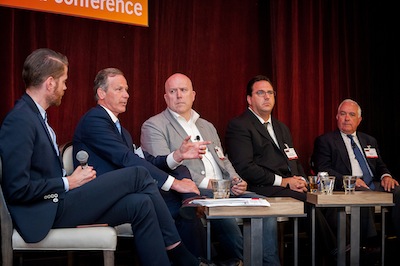 GM and FCA are both exploring opportunities of using in-vehicle telematics systems to mange vehicle distribution
GM and FCA are both exploring opportunities of using in-vehicle telematics systems to mange vehicle distributionGlenn Clift at Glovis said Hyundai and Kia were considering how it could use telematics for yard management, but not all of the brands’ vehicles were equipped with it. “In some cases the system has not been activated and you have to pay for the service,” he said.
ProAct's Paul Nurse said the volume of telematics across all vehicles now verged on the concept of Big Data – extremely large data sets that can be analysed computationally to reveal patterns. However, without the right analytics to interpret it and derive useful and immediate applications for the supply chain, it risked being “expensive noise with minimal value”.
For example, the potential benefits for vehicle yard management could be numerous according to Nurse, especially when combined with developments in autonomous vehicles. In conversation with yard management technology, vehicles could be told which bays to park in or where to charge a vehicle with a low battery. The combined technology could even see multiple vehicles moving autonomously while communicating amongst themselves.
“There are endless possibilities but the value of telematics will ultimately be decided almost wholly by the intelligent control solutions that receive, interpret and respond to the data,” said Nurse.
Some carmakers in Europe, including BMW and Jaguar Land Rover, have said they are trialling the use of telematics in vehicle distribution. Legislation for various kind of telematics and satellite-based tracking systems in vehicle in both Europe and Russia may well encourage others to do.
Second-hand news with top value [sta_anchor id="6"]The importance of data and how to make the best use of it with technology was also heard regarding the used vehicle market, where carmakers want their transport and logistics providers to be data analytics experts.
Kurt Cornell, general manager for dealer operations at Mercedes Benz USA said the company was looking to sell its de-leased vehicles before they even arrive at auctions or dealerships to stem the fast value depletion of units typical of the second-hand market. He expected logistics companies to tell Mercedes-Benz how to do that.
“You [LSPs] are handling millions of cars and we have a couple of hundred thousand coming off lease,” he observed. “When we take a look at who has got the information it is not us, it is the logistics companies. We expect any logistics company to be a sophisticated data analytics company that happens to also provide vehicle transport.”
His point was backed up by Bryce Bentley, co-founder and vice-president of business development, at Ready Logistics, a division of Cox Automotive.
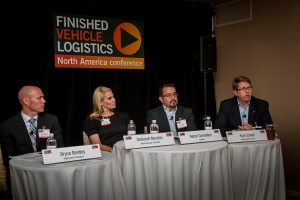 Ready's Bryce Bentley; Montway's Deborah Newton; Hyundai's Aaron Cervantes; Mercedes-Benz's Kurt Connell
Ready's Bryce Bentley; Montway's Deborah Newton; Hyundai's Aaron Cervantes; Mercedes-Benz's Kurt Connell“It is becoming more critical for the carriers and the drivers to be using the technology that exists today,” he said. “What Hyundai and Mercedes are looking for is full time information on where the car is. The day is coming very soon when there is going to be a demand for rerouting while [the vehicle] is actually on route. Knowing where the vehicle is at and whether the driver has picked it up or not is critical.”
Transport is obviously a central component of the used car value chain but transparency here needed to improve, said Bentley, especially given that dealers are experiencing record high volumes on used car side but are also seeing thinner margins.
He explained that Ready had developed a hub client portal with its customers for communicating information on the location, the condition of the vehicles and any delays in pick up. “Whether recall or off lease, getting the vehicle picked up is often taking too long and the carrier is blamed when it is often nothing to do with them whether the car is ready or not,” said Bryce.
Orders received are sent via the hub to the pick up location then making it the responsibility of that location to respond stating whether the car is ready for pick up or not.
“That is important because every piece of the communication is being tracked so the clients can see whether it is a repo location, a dealer or wholesale, or a storage facility,” said Bryce. “They can see where the delays are happening and make decisions based on analysis of the data.”
Deborah Newton, director of strategic planning at Montway Auto Transport, which runs a carrier broker system, also agreed that timely car data analytics was something any remarketing team needed from the start, along with information on buying patterns, area dealer inventory and competing vehicles.
“We are wasting time,” she said. “We need to partner with all parties involved and share information to make things quicker.”
The area that incurs the biggest waste of time is at marshalling yards, according to Newton, where cars that lose value by the day often spend a week before moving on. To make the best decision on saving time and money, she said Montway needed industry-wide information sooner and from multiple sources.
Blocking and tackling [sta_anchor id="7"]The potential for collaborative processes to improve efficiency, whether for new or used vehicles, may prove to be the industry’s best defence against any skinny cows or stormy weather. That may well involve better technology, from mobile apps to RFID and telematics, but it may just as well come down to what Marc Brazeau calls “blocking and tackling”: working together with logistics partners and, where feasible, competitors to improve loading, load transfers and dwell time.
“We've benefitted from good weather and rail freeing up track capacity to allow better velocity, but we would like to still focus on taking waste out, destination dwell time, interactions between us and railroads and ramps and haulaway companies, and new technology coming up,” he said. “While we have the time to makes these changes, let's not overcomplicate the solutions and instead focus on the things we do well together when we co-operate.”
The Finished Vehicle Logistics North America Conference is part of the global Automotive Logistics series of conferences.
The next conference in the series is Automotive Logistics Russia in Moscow on June 28-29th.
The next conference in North America will be Finished Vehicle Logistics Import Export North America in Baltimore on August 10th.

























![Global[1]](https://d3n5uof8vony13.cloudfront.net/Pictures/web/a/d/s/global1_726550.svgz)








